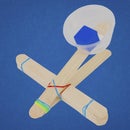Introduction: Geometric Shapes
Students use pieces of straws, craft sticks, and tape to form geometric shapes of varying complexity.
You can find the lesson plan, 1-page project sheet, and more project ideas at STEM-Inventions.com
Step 1: Materials
The Engineering Creation Kit has everything you need for this project and many more from STEM Inventions.
Geometric shapes:
Extra recommended materials
More!
When you make a purchase through these links, I may earn an affiliate commission at zero cost to you.
Step 2: Basic Construction
Construction is simple: pinch the end of a straw to flatten the opening, then insert a craft stick about half way in. Continue this process until the desired number of sticks are connected, then close the shape by connecting the ends together.
Use tape to prevent the pieces from falling apart. Peel a small length of tape from the roll, but do not cut it. Attach the tape to the shape and wrap it around the perimeter as you unroll more tape. Cut the tape only when the entire perimeter of the shape is covered.
Remember, this process requires a lot of patience. Some students are easily bored with structural engineering projects. If a student is not engaged with the project, work with him/her to figure out what the shape can be used for. Could you transform a prism into a cybernetic arm attachment? Or turn a simple cube into a house by adding a pyramid on top and covering the sides with decorated paper? Be imaginative!
Step 3: Forming 3D Shapes
Shapes can be connected simply by taping the edges together. Lay the 2D shapes flat on a table, tape the edges together, then raise the shapes into a 3D pattern. Students may refer to your 2D schematics to figure out how to piece their shapes together. For unique shapes, offer your consultation, but allow the students to decide for themselves how they want to construct their shape.
Step 4: Advanced Ideas
More complex shapes can be formed by combining many simple shapes.
Step 5: Safety, Tips and Troubleshooting
Caution! This project can cause small puncture wounds. If a stick is inserted into a straw without first pinching the opening, the straw can cut off the edge of the stick, creating a sharp splinter. When forcing a stick into a straw, the splinter can quickly form and get pushed into the fingers. If you see students who are not pinching a straw before inserting a stick, remind them of the dangers and supervise them as they properly connect the sticks at least one time.













